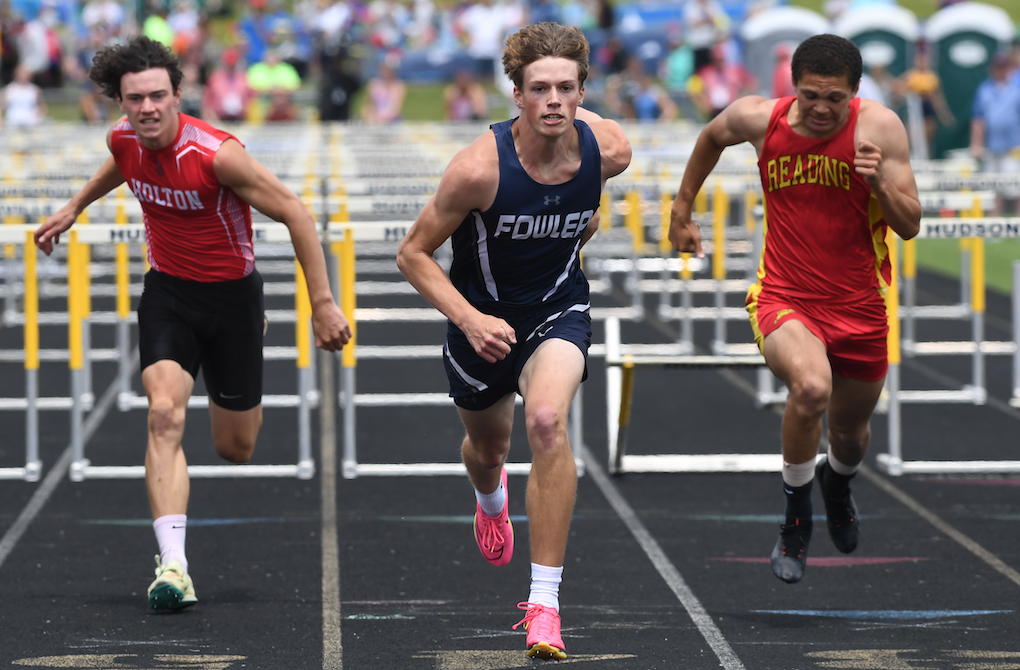
Add, Subtract, Divide, Multiply: MHSAA Not Alone
July 25, 2017
By Rob Kaminski
MHSAA benchmarks editor
This is the third part in a series on MHSAA tournament classification, past and present, that will be published over the next two weeks. This series originally ran in this spring's edition of MHSAA benchmarks.
As the MHSAA faces its most recent classification task with 8-Player Football, and opinions continue to swirl about as to the method, timeframe, location and other procedures, a look around the country provides plenty of company among state association brethren factoring variables into their own equations.
In the Pacific Northwest, the Oregon School Activities Association Football Playoffs are under public scrutiny as leadership ponders a five or six classification format beginning with the 2018-19 school year.
The OSAA has crowned six champions on the gridiron since 2006-07. Many of the state’s smaller schools would like to keep it that way, while larger schools lean toward a five-classification system, citing larger leagues, ease of travel and credibility to state championships as the advantages.
Still others would prefer more than six classes, pointing to safety issues and the opportunity to increase participation numbers as positives.
Moving southeast of Oregon, the Nevada Interscholastic Activities Association recently voted to hold serve on a classification proposal that was volleyed to the membership.
However, changes still could be forthcoming by as early as the 2018-19 season which would add a fifth classification in more populated southern Nevada while allowing northern schools to participate in four classifications. Such divisions could mean no state championship for the fifth class in southern Nevada.
Because of that, the NIAA wants equal numbers of schools in each classification on both ends of the state. Complicating the issue is the fact that the 24 largest schools in the state, by enrollment, are all in Clark County in Southern Nevada.
Across Nevada’s border into Arizona, charter schools are asking the Arizona Interscholastic Association to reconsider classification that was voted upon and approved in September 2015. That agreement called for the largest 33 percent of charter schools by enrollment to be placed in the state’s largest school classification, 3A, the middle 33 percent into 2A, and the smallest 33 percent into 1A.
Less than two years later the charter schools have had a change of heart and have asked to be considered the same as other Arizona public schools and be placed appropriately by enrollment beginning with the 2018-19 school year.
The situation in Arizona further illustrates how the public/private debate that all state associations have faced throughout existence now has the added dynamic of rapidly growing charter schools in today’s educational system, along with virtual school enrollment.
In the nation’s heartland, Nebraska has retooled its football classifications by using enrollment of boys students only in its schools rather than total enrollment. The Nebraska School Activities Association football-playing schools will kick off the 2018 season using this alignment.
Nebraska has three classes of 11-player football, with the smallest class divided in two, Class C-1 and C-2. The state also will have 8-player football for boys enrollments under 47, and the NSAA will sponsor a new 6-player tournament in 2018 for schools with 27 or fewer boys.
“This is a good proposal because some schools have a sizable imbalance between the number of boys and girls, and there’s a large gap (in enrollment) between the largest and smallest schools in Classes A and B,” NSAA executive director Jim Tenopir said. “I think this addresses both of those concerns.”
Swimmers in Georgia, meanwhile, will feel like they are moving with the current, rather than upstream in 2017-18, as the Georgia High School Association recently doubled the number of team championship events from two to four.
Swim enthusiasts can also count on longer days at the finals, as the top 30 finishers from the prelims will advance to the finals instead of 20, and all championship events will have three heats versus two.

Fowler Boys Clinch 1st Team Title since 1988, Buford Leaps Into Record Book
By
Keith Dunlap
Special for MHSAA.com
June 2, 2024
HUDSONVILLE — In 2023, Anthony Buford of Detroit Frederick Douglass would have won the long jump at the MHSAA Lower Peninsula Division 4 Track & Field Finals if not for a historic effort.
Buford nearly was first, but had to settle for second after Peck’s Alex Affer jumped a meet-record distance of 23-feet, 1.5-inches.
Affer graduated last year, but he still was providing Buford plenty of motivation when he started the long jump event at this year’s event.
“My main motivator all year has been my main guy Alex Affer, the former record holder at 23-1,” Buford said. “He was really anticipating me breaking his record this year.”
Buford made good on Affer’s proclamation by setting a new Division 4 Finals record, jumping a recorded distance of 23 feet, 2 inches, into a headwind to best what Affer achieved a year ago.
“I was really surprised I broke it with that headwind I was jumping into,” Buford said. “But honestly, I just had to make it happen.”
Oh, but Buford wasn’t done during his busy and successful day.
Buford then won the 400 dash, finishing first in a time of 49.91 in a headwind and with rain coming down.
“I’ve been fighting to beat 49 (seconds) all season,” said Buford, who decided to focus on the 400 meters and long jump this year after primarily competing in the 100 and 200-meter dashes last year. “Just to come out here and beat my time while it was raining and a headwind coming into my face, that really shows how much more mentally tough I’ve gotten over time.”
 Buford was also second to teammate Adrian Smith in the 200 and ran in the 1,600 relay to help Douglass finish second on the day.
Buford was also second to teammate Adrian Smith in the 200 and ran in the 1,600 relay to help Douglass finish second on the day.
Buford’s performance wasn’t quite enough to lift his team past Fowler, which captured the team title with 56.5 points, four more than Douglass. It was Fowler’s first Finals team championship since 1988.
Brady Feldpausch led Fowler’s point scoring by finishing first in the 110 hurdles with a time of 14.57, running as part of the winning team in the 800 relay, taking second in the 300 hurdles and then being a part of the winning 1,600 relay that clinched the title.
“It feels amazing,” Feldpausch said. “I don’t know what to say. We just all have the same mindset. We come to practice and work hard. We knew if we all ran like we knew how to, we’d have a shot.”
Fowler entered the last event, the 1,600 relay, knowing that in order to clinch the team win it had to win the race and have Douglass finish fifth or lower.
A strong event all year for the Eagles, they delivered again, winning in a time of 3:26.43. Pair that with a ninth-place finish by Douglass, and Fowler had what it needed.
Fowler head coach Brett Schafer credited unsung heroes with stepping up for his team and fulfilling a goal talked about all year.
“We scored in field events where we didn’t expect to,” he said. “Our first meeting with them at the start of the year, our whole goal was to hang a banner in the gym. We did that today.”
Kalamazoo Hackett Catholic Prep took third with 44 points after winning the last two LPD4 team titles.
PHOTOS (Top) Fowler’s Brady Feldpausch, left, edges Reading’s Tayshawn Bester to win the 110 hurdles Saturday at Baldwin Middle School. (Middle) Detroit Douglass’ Anthony Buford finishes his win in the 400. (Click for more from Ken Swart/RunMichigan.com.)

